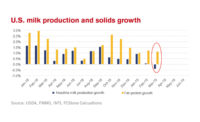
Measuring Up
By James Dudlicek
pportunities continue to
abound for dairy products at home and abroad. Despite stagnant and slipping
fluid sales, consumers still are flocking to their favorite dairy foods,
whether for health concerns, indulgence or comfort.
Nutrition and obesity are issues that continue to
dominate the food industry scene. And while animal rights extremists try to
undermine efforts to promote dairy as beneficial to health and weight
management, scientific evidence continues to mount that milk presents a
treasure trove of benefits to the human body.
The low-carb craze came and went, but from its ashes
the best of the sugar-free and NSA products remain to serve a growing
demographic that seeks to reduce or eliminate sugar from their diets. More
are coming to recognize that calories count, and those looking to reduce
their intake will find new attention paid to fat content.
In the frozen arena, Dreyer’s Slow Churned Light
has been a wild success; the company predicts sales will soon overtake that
of its regular ice creams. It wasn’t long before competitors also
began to introduce products made with similar technology that promises the
taste of superpremium ice cream but with a fraction of the fat.
Among cultured products, Dannon introduced a line of
yogurts with a boosted fiber content. Meanwhile, Yoplait added plant
sterols — shown to help lower cholesterol — to a range of its
products, building upon its support of research to unlock dairy
calcium’s key to weight loss, efforts the rest of the industry soon
followed. The yogurt segment remains strong overall, as consumers gradually
become more educated to the benefits of probiotics as delivered by tasty
dairy foods.
Cheese continues to be a favorite, with growing
success owed in part to a lack of trans fats and inclusion on the menus of
popular reduced-carbohydrate/high-protein diet plans. Revised school
nutritional guidelines have opened up fresh opportunities for improving
school milk programs and raising new generations of enthusiastic milk
drinkers. And the demand for organic dairy products continues to grow by
leaps and bounds.
In all, nearly a thousand new SKUs of dairy foods
across all product categories have been introduced so far this year,
according to Productscan Online.
But as processors worked to develop new products,
lawmakers fought to gain more access to global markets so as to share these
innovations with the rest of the world. Demand for dairy products —
especially those with health benefits — continues to grow abroad, and
the U.S. Free Trade Agreement with the Dominican Republic and Central
America (DR-CAFTA) is another foot in the door for the U.S. dairy industry
and the U.S. agricultural sector as a whole.
| Changing Dairy Product Sales* | |
| Cheese | 0.7% |
| Yogurt | 10.7 |
| Fat-free milk | -3.9 |
| Buttermilk | -6.0 |
| Reduced fat/lowfat milk | -1.2 |
| Cottage cheese | 3.8 |
| Whole milk | -1.7 |
| Sour cream | 11.0 |
| Flavored milk | 2.7 |
| Eggnog | 4.5 |
| Creams | 14.5 |
| Ice Cream | 5.2 |
| *Percent change in per capita sales ofselected dairy products, 2002-03. SOURCE: Dairy Facts 2004, International Dairy Foods Association. | |
Not only will the trade agreement tear down
barriers to trade in these markets, it is expected to help lower
the cost of doing business at home by allowing less expensive sugar
onto our shores. This should benefit processors who purchase ingredients to
manufacture the dairy food products that are in the highest demand: frozen
desserts, yogurt and flavored milk.
“The inclusion of sugar in the DR-CAFTA
agreement is a significant step forward in allowing U.S. dairy
processors access to more competitively priced world sugar,” says
Connie Tipton, president and chief executive officer of the International
Dairy Foods Association. “If companies were able to purchase sugar at
world prices, the dairy industry could save as much as $110 million
annually.” Under the full terms of the agreement, U.S.
companies will be able to import 109,000 metric tons of sugar from the
DR-CAFTA nations within the first year; this amount will grow to about
153,000 metric tons annually over 15 years.
With that, Dairy Field offers its annual State of the Industry report, with an
in-depth look at each category, focusing on brand leaders and product
trends. We also take a look at the global market, ingredients and the deli
scene.
$OMN_arttitle="Measuring Up";?>
